We made it! (Almost.)
The 2020 regular season has had its ups and downs, stops and starts, but we're almost there. We're almost through. The postseason starts a week from Tuesday, and for as weird as everything has been, there's a lot of familiar teams -- Dodgers, A's, Cubs, Rays, Braves, etc. -- atop their divisions. The surging White Sox and Padres are coming off many losing seasons, but they were also popular breakout picks. We knew the Red Sox and Astros would have pitching problems, and that the Indians wouldn't get much offense from their outfield, and that's all played out as expected. How much of that, really, is weird?
Still, it's worth looking into what particular things the projected 16 playoff teams have been good at, and see what mattered the most. Have the successful teams posted higher batting averages? Lower strikeout rates? Have they succeeded in more advanced stats?
What's mattered? Let's find out what worked in this 60-game abbreviated season.
(All numbers are current as of Thursday morning.)
Barrel rate (batting)

OK, well, strong start here! Every single one of the top 13 teams in barrel rate is on track to make the postseason. Every single one of the next 11 teams would miss the postseason! If you want to win, do this. Do this so often. It is the most important thing.
A barrel, for those not in the know, is a Statcast metric that's essentially the perfect combination of exit velocity and launch angle. (That is: you want to hit the ball hard, and you want to hit it hard in the air. In order to be a barrel, that combination has to come out to a minimum of a .500 expected average and a 1.500 expected slugging. In 2019-20, hitters have an actual average of .811 and a slugging of 2.797 on barrels. It is a fancy way of saying mash baseballs.)
Of the bottom 17 teams in this, only three are currently on track to make the playoffs. (Three!) Setting aside Miami, the most interesting are the two in the bottom four overall, Houston and Cleveland. How are they doing it? Well, the Astros barely are; they're right at .500, and are in only because the non-Oakland rest of the AL West is so weak. Cleveland has compensated with baseball's best pitching; in addition, they lost eight in a row before Thursday and still might not even make it in.
It's not just a "weird small sample year" thing, either. In 2019, six of the top seven barrel rate offenses made the playoffs. In 2018, it was five of the top six. You get the idea. Barrel up baseballs. It's how you win.
What about on the pitching side? Preventing this should be a good thing, right? Well, yes. Sort of.
Barrel rate (pitching)
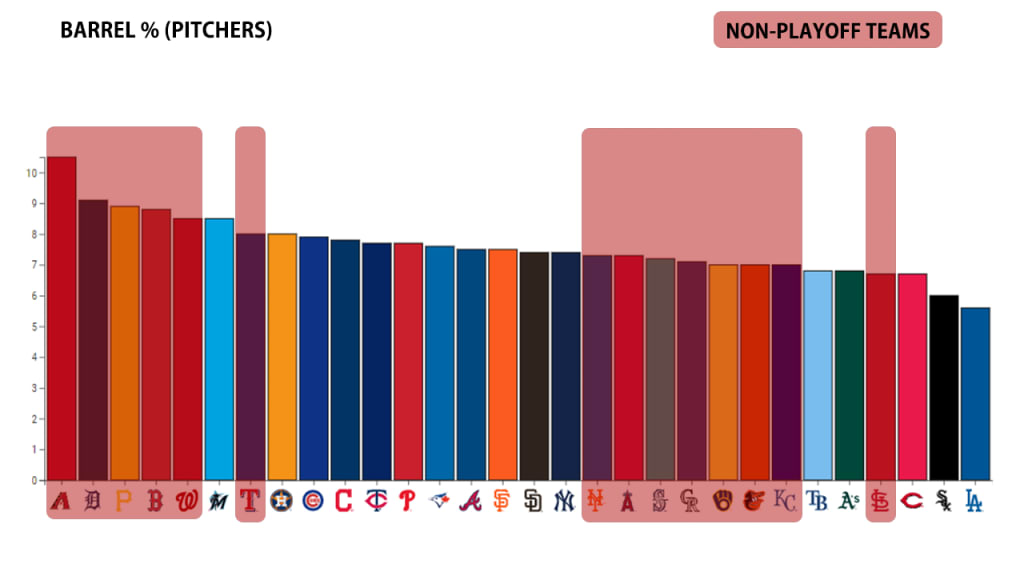
If you're very good at preventing the loudest kind of contact -- see the Dodgers, White Sox, Reds, A's and Rays -- you're generally in good shape. If you're allowing a ton of that dangerous contact -- see the D-backs, Tigers, Pirates, Red Sox, and Nationals -- you're basically toast. But what about that middle part? Why are all those non-playoff teams (like the Royals, Rockies, and Mariners) doing better at this than "better" teams like the Twins, Indians, and Yankees?
Because this is looking at barrel rate per batted ball, not per pitch, and that gets us to something important. For batters, what happens when you make contact is really, really important, moreso than how much contact is made. For pitchers, it's important not to be literally the worst at allowing hard contact and it's helpful to be the best, but in the middle, it doesn't matter as much as not allowing contact in the first place.
The incentives, in other words, are not aligned equally for pitchers and hitters. Which is a nice segue for us to go and ask the next question: How important is strikeout rate?
Strikeout rate (batters)
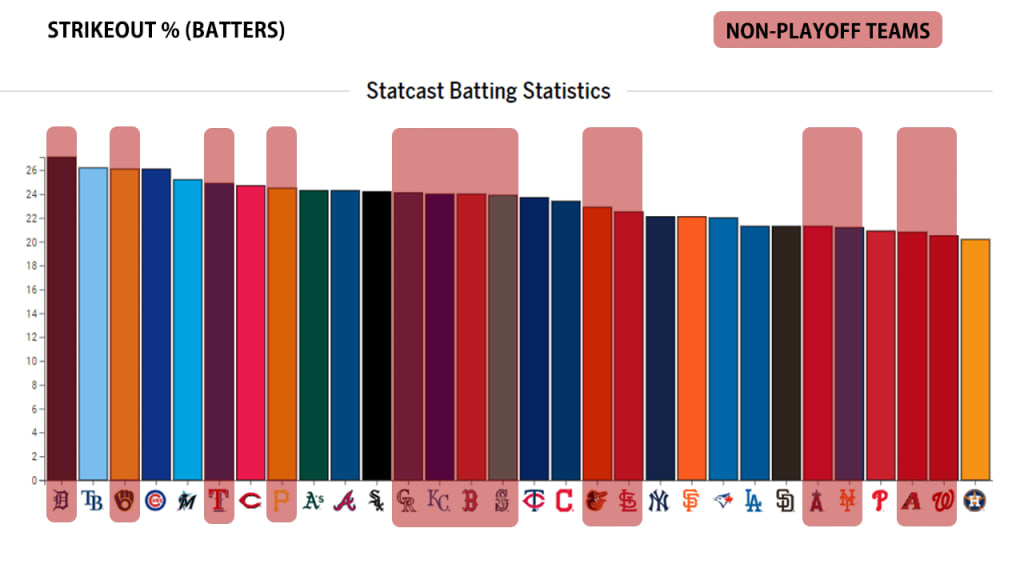
Despite all the focus on myths like "small ball wins in the playoffs" and reminders that the last four World Series champions all finished in the bottom (best) five of strikeout rates in those seasons, this one is ... pretty inconclusive.
The three lowest strikeout rates in baseball belong to the Astros, who are a .500 team and have a league-average offense and are the Astros; the last-place Nationals; and the last-place D-backs, who have one of the weakest offenses in baseball. They're making lots of contact, sure. It's just not good contact.
On the other end, the second-highest strikeout rate belongs to the Rays, who have the 9th-most runs scored, the 8th-best offense and are likely to win the AL East.
Is it better to make contact than not make contact? Sure, a little. The Dodgers and Padres and even the outside-the-playoffs Mets are all strong offenses, and they're near the low end of the scale. Does this matter in any way as much as people think it does? Not really.
Of course, it's a very different story on the pitching side ...
Strikeout rate (pitchers)
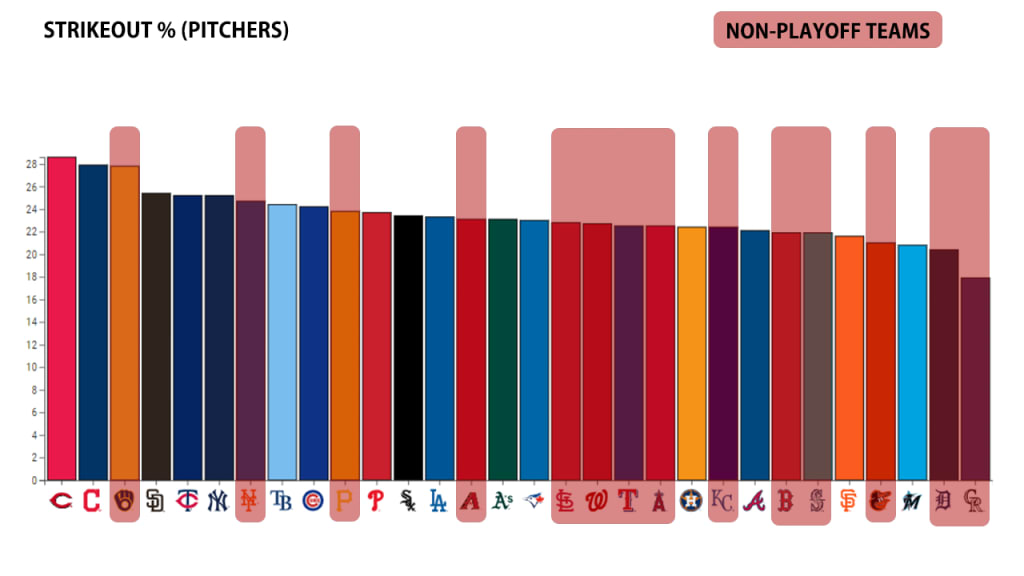
Let's split this in half, right after the A's. Of the top 15 pitching teams in strikeout rate, 11 (or about 74%) are playoff teams. Of the bottom 15 teams in strikeout rate, five (or 33%) are playoff teams. Miss those bats, pitchers.
This, again, gets to the heart of baseball's neverending strikeout increase: It matters a lot more for pitchers than it does for hitters. That is, you can be a successful hitter while striking out a lot; just look at Aaron Judge, or Miguel Sanó or a dozen others. But unless you're an extreme groundballer like Dallas Keuchel or a control king like Kyle Hendricks, it's really, really hard to succeed as a pitcher who doesn't miss bats.
Pitchers almost always have to care about this. Batters, quite often, don't.
That the Brewers (third-best pitching strikeout rate) are unlikely to make the postseason tells you a lot about how weak their offense has been. (Remember that Lorenzo Cain chose not to play the remainder of the season on Aug. 1, and Christian Yelich is hitting a mere .208/.338/.440.) On the other end, the Marlins haven't missed any bats, and haven't actually been that effective on the mound (4.61 ERA), and their offense has been slightly below average, and how exactly are the Marlins getting into the postseason, anyway?
Let's stick with a traditional metric to look at ...
Batting average (batters)
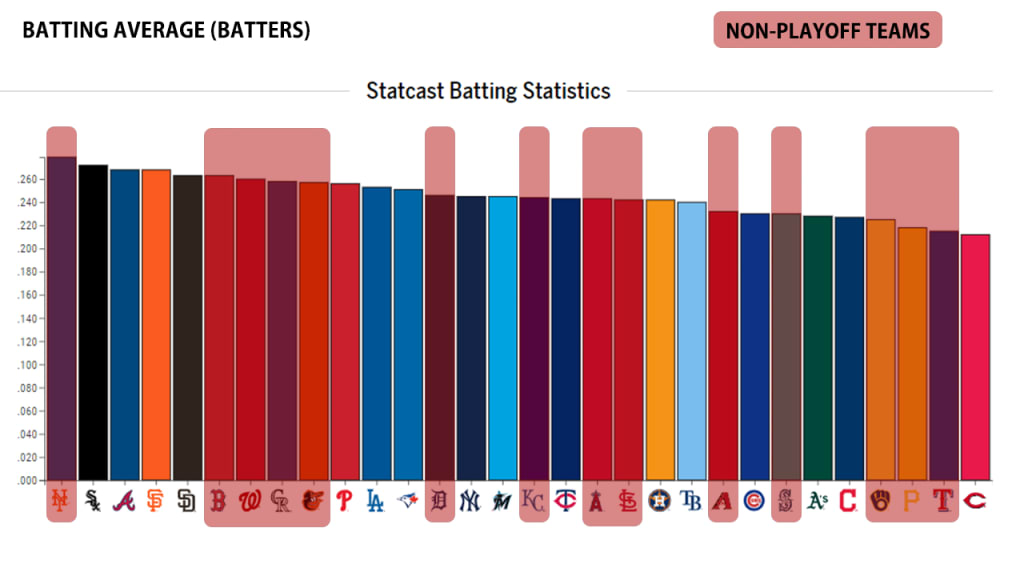
Similarly, this one's all over the place. You might notice that the team with the best batting average (the Mets) would miss the playoffs if they started today. The team with the worst batting average (the Reds) would be in. So there's that.
It's too much to say that this doesn't matter at all, because if given the choice, you'd prefer to be good at this than not, and even the Mets do actually have a very good offense. There's just not a lot of consistency here, so far as it goes towards team winning.
Let's try something a little more advanced. How about ...
Expected Weighted On-Base Average, or xwOBA (Hitters)
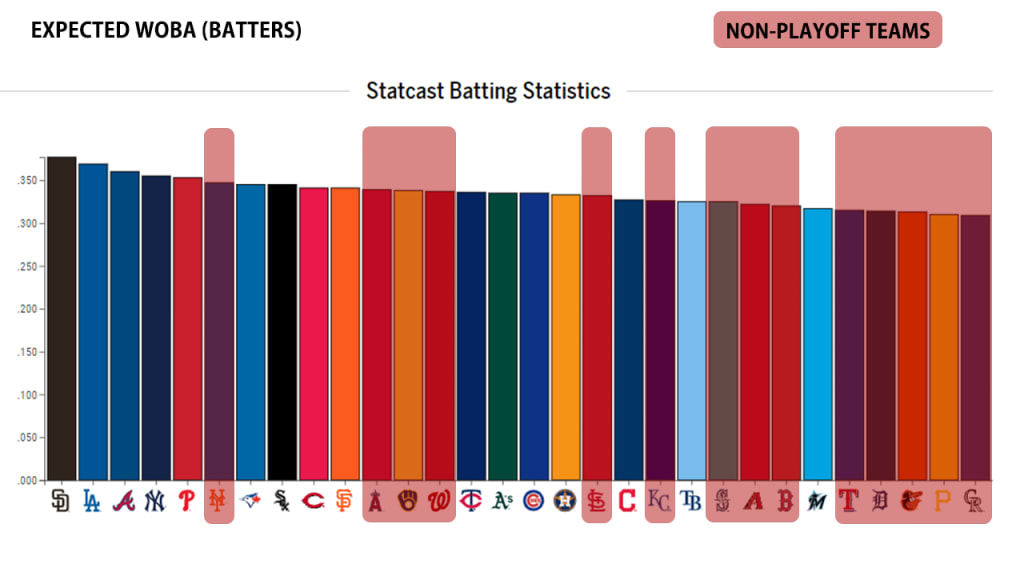
Barrels, as important as they are, represent only about 1% of pitches and 7% of batted balls. They're important, but they leave out so many other pitches. What about them? For that, we turn to Expected wOBA, which accounts for both quality of contact (exit velocity and launch angle) as well as amount of contact (strikeouts and walks). The 2020 MLB average is .335; think of it like a version of on-base percentage that gives more credit for extra base hits than walks.
If you're good at those things -- hitting the ball hard, in the air, while also drawing walks and making enough contact to hit it hard in the air enough -- you're probably going to be a pretty good team. That's mostly expressed here, where only the disappointing Mets prevent us from saying "the top 10 offenses by this metric make the playoffs." On the other end, only the confounding Marlins prevent us from saying "the bottom nine offenses by this metric fail to make the playoffs."
This, as we said, is a combination of several things, not just one, and when you combine several things it's good to be good at, you'd expect to see a nice correlation to success. You do. If we look at the pitching end of this ...
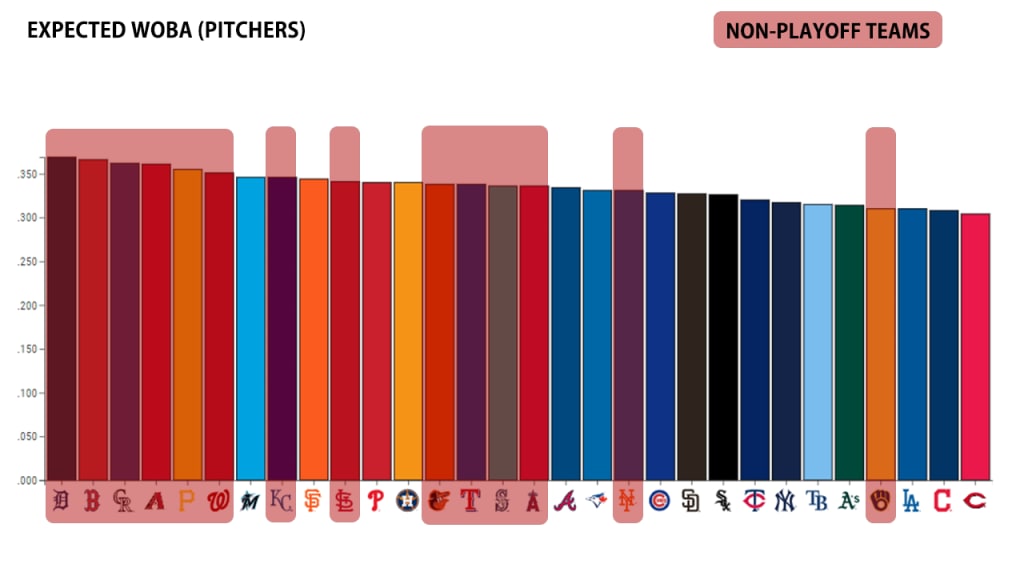
... we'll see more of the same. It's actually a little more extreme by this view; 12 of the 14 best pitching teams in Expected wOBA, excepting the Mets and Brewers, are in playoff position. Only one of the bottom eight, again the Marlins, can say the same.
This tells you that the Reds, Indians, and Dodgers have baseball's three best pitching staffs -- remember, this is all about what happens at contact, or lack thereof, trying to eliminate the effects of defense, ballpark, and luck -- and that the Tigers, Red Sox and Rockies have the three weakest. That all tracks, and that the good pitching staffs (Milwaukee aside) are all headed to October is unsurprising.
So: What matters this year? The same thing as matters every year. If you're pitching, you want to miss as many bats as you possibly can. Nothing is more important. If you're hitting, you want to make as much loud contact as you can, preferably in the air. Nothing else is more important.
That's not new for 2020, by the way. It's mostly the same thing every year. It's the same thing this year, too.
